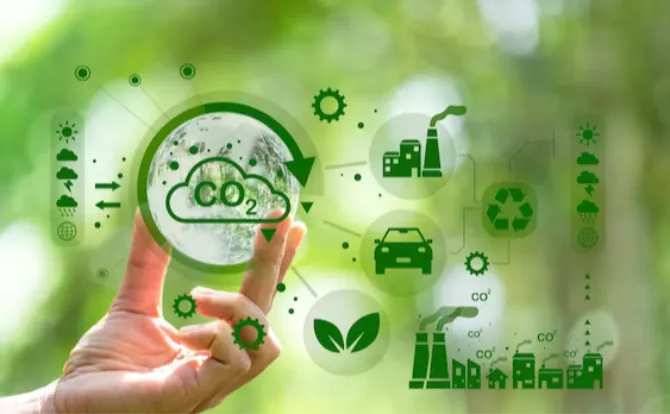-
CENTRES
Progammes & Centres
Location
If the energy needs of the future population are to be met, India must reduce its dependence on non-renewable resources and become self-reliant in the production of green energy

There is increasing anxiety among environmentalists over the Earth’s deteriorating condition. Their view is based on an analysis of temporal temperature data that indicate an increase in Earth’s temperature by about 1.10 Celsius during the period 1880 to 2022. According to the scientific community, a future rise in temperature will lead to the occurrence of major social, economic, and environmental problems. This article describes global thinking on climate change and the progress of green energy initiatives in India. There is a rise in the frequency of news regarding the changing climatic conditions. Some problems noted in various world regions are the frequent occurrence of droughts, forest fires, ice melting, rising ocean/sea water levels, flooding, and catastrophic storms/cyclones. Each of these is significantly affecting people’s lives.
According to the scientific community, a future rise in temperature will lead to the occurrence of major social, economic, and environmental problems.
The rise in water levels, saltwater intrusion, and coastal erosion, for example in the Sundarban area adjoining the Bay of Bengal, has led to the migration of farmers and fishing communities. The relocation deprived communities of their livelihood and pushed them into poverty. Similarly, multiple wildfires in Greece during July-August 2023 killed several people, injured many, and damaged built structures and infrastructure. China experienced excess rainfall and devastating floods in August 2023, which resulted in the displacement of more than a million people. Considering the rise in the occurrence of unforeseen events, climate refugees are expected to increase in future. Other projected social and economic concerns arising from temperature rise and climate change include reduced agricultural production, price rise of commodities, widespread poverty, the spread of diseases, water shortages, conflicts over limited resources, and low productivity at work. Two main reasons for the occurrence of climate problems are provided by the scientific community: First, changes in the intensity of solar energy reaching the Earth, coupled with increased volcanic activity; and second, burning of fossil fuels (such as coal, oil, and gas) by human beings for various purposes. More recently, scientists are claiming that the Sun’s role in climate change has reduced over the years, and since the mid-20th century, the use of fossil fuels as well as other environment-unfriendly human activities are responsible for global warming. These are related to the usage of energy in sectors such as transport (motor vehicles), industry (power plants), infrastructure (roads, water, sanitation), residential (heating and cooling of buildings), and damage caused to the environment by deforestation and pollution of surface water bodies.
Multiple wildfires in Greece during July-August 2023 killed several people, injured many, and damaged built structures and infrastructure.
In this regard, it is noted that most nations are pursuing carbon-intensive approaches for development, and the constant use of fossil fuels is generating greenhouse gases such as carbon dioxide, nitrous oxide, and methane that adversely affect the atmosphere. In this condition, the energy/heat received from the sun is not adequately reflected into space. Instead, the gases (produced from the use of fossil fuels) in the atmosphere absorb most of the heat, which is radiated in all directions over the Earth thereby causing global warming.
The energy sector is a major source of greenhouse gas emissions. Thus, there is consensus on reducing dependence on conventional sources of energy (i.e. fossil fuels, uranium) and shifting to environment-friendly sources of energy, or green energy. According to United States’ Environmental Protection Agency, green power is electricity produced from sources such as wind, sun, biomass (organic material that comes from plants/animals), geothermal (heat inside the Earth), biogas (gas produced by bacterial decomposition of organic matter derived from remains of plants/animals), and low-impact small hydropower projects (use of the natural flow of moving water to generate electricity).
It is noted that most nations are pursuing carbon-intensive approaches for development, and the constant use of fossil fuels is generating greenhouse gases such as carbon dioxide, nitrous oxide, and methane that adversely affect the atmosphere.
Further, there is an emphasis on conducting human activities in an environment-friendly manner. For the transport sector, recommendations include the use of public transport, shared vehicles, electric vehicles, and non-motorised transport. For houses/workplaces, options provided are shifting to renewable energy sources (wind/solar) and energy-efficient electronic gadgets. Next, shopping is a popular activity, and in this regard, the purchase of goods (such as clothes) beyond requirement is discouraged, since energy is utilised in their production. The consumption of non-vegetarian food (especially red meat) is also a matter of concern as it involves the use of resources (water, land) for raising animals. An equal importance is given to reducing/reusing/repairing/ recycling of products and resources (water, liquid, and solid waste). There is growing evidence of communities adopting the available options. The United Nations (UN) has called upon world leaders to reduce their emissions by 2030 and reach net zero (i.e. close to zero emissions) by 2050. Further, industrialised countries have been asked to provide US$100 billion as climate finance a year to developing countries for climate change mitigation and adaptation, and strengthening resilience. While most nations have pledged to these proposals, till date, only a few have partly adhered to them. The UN is increasingly concerned as some nations (namely the United Kingdom) have begun to backtrack on their climate goals, as these prefer energy security (from available resources) to net zero. The UN Secretary General, António Guterres, notes, “Children are swept away by monsoon rains, families are running from flames, workers are collapsing in scorching heat, the air is unbreathable, and heat is unbearable.”
India, the world’s most populous nation, has initiated a number of green initiatives and aims to improve its emissions ranking. It is currently the fourth largest global emitter, after China, the United States (US), and the European Union (EU), and the goal is to achieve 50 percent power from non-fossil fuel-based energy resources by 2030 and reach net zero by 2070.
The UN is increasingly concerned as some nations (namely the United Kingdom) have begun to backtrack on their climate goals, as these prefer energy security (from available resources) to net zero.
Way back in 2010, the National Solar Mission was launched that included the nation-wide implementation of schemes such as solar parks (solar infrastructure development over a large land area), mega solar power projects, Kisan Urja Surakhsha (farmers given financial support to install solar irrigation pumps), rooftop solar projects, and green energy corridor (setting up intra-state transmission lines and sub-stations charged by solar power). Until the end of 2022, solar power of 63.30 gigawatt (GW) capacity is installed in India, and the states of Rajasthan, Gujarat, and Karnataka have shown good progress. In 2022, the National Bio-energy Programme was implemented to recover energy from biomass (such as agricultural residue, wood, palm leaves, cocoa shells, husk, and solid waste). Over 800 biomass plants have been installed across the country (in the states of Maharashtra, Uttar Pradesh, Karnataka, etc.), and this source accounts for 10.73 GW installed capacity. The National Green Hydrogen Mission is a recent (2023) initiative under which about 5 million metric tonne capacity is expected to be produced per annum by 2030. Other important on-going initiatives are generation of energy from wind, wind-solar hybrid and small hydro projects. Together, these account for 46.87 GW installed capacity. Until 31 December 2022, the total installed capacity from various non-fossil fuel sources in India was 167.75 GW. In addition, 78.75 GW capacity projects are being implemented, and 32.60 GW capacity projects are under bidding. Upon completion of work, up to 280 GW installed capacity would be available. The above data on installed capacity by source reveal that, at present, the contribution of the solar power sector is highest, which is followed by wind, bio-energy, and small hydro sectors. For the development of the green energy sector in India, the Ministry of New and Renewable Energy (MNRE) has allocated an amount of INR 102.22 billion for 2023-24. Solar and wind energy projects have received the highest allocations in comparison to bio-energy, hydrogen, and hydropower projects. Some amount is also kept for human resources development and R&D.
In Coimbatore and Salem, solar rooftop infrastructure is installed to meet electricity demand.
Some green projects have also been implemented under the Smart Cities Mission. In Coimbatore and Salem, solar rooftop infrastructure is installed to meet electricity demand. The green electricity produced has improved citizens’ access to affordable and reliable supply of electricity, and the supply agencies are benefiting by way of conventional thermal energy and fund savings. Similarly, energy generated from floating solar plants at the waterworks in Chandigarh is helping in meeting demand and lowering power bills. Indore, on the other hand, has set up a bio-CNG plant that treats segregated wet waste. The biogas produced is used to run city transport buses. Besides, there are numerous examples of green energy generation (mainly solar power) at the household and institutional levels in various parts of India. In terms of India’s progress on green energy production, some ground has been covered. At the end of 2022, the government acknowledged an installed capacity of 168 GW or 40 percent of energy production from renewable sources. But fossil fuels still dominate energy consumption and account for nearly 60 percent of the installed capacity. About 85 percent of oil and 45 percent of gas are imported every year. There is also the challenge of meeting the growing energy demand arising from urbanisation, expansion of transport infrastructure, and industrial production. If the energy needs of the future population are to be met in a responsible manner, India must reduce its dependence on non-renewable resources and become self-reliant in the production of green energy. This approach requires collaboration of stakeholders, better implementation of green initiatives, maintenance of green assets created, offering affordable and efficient alternatives to people, and changes in people’s habits and attitudes.
Rumi Aijaz is a Senior Fellow at the Observer Research Foundation
The views expressed above belong to the author(s). ORF research and analyses now available on Telegram! Click here to access our curated content — blogs, longforms and interviews.

Rumi Aijaz is Senior Fellow at ORF where he is responsible for the conduct of the Urban Policy Research Initiative. He conceived and designed the ...
Read More +